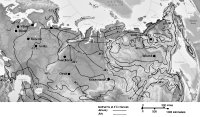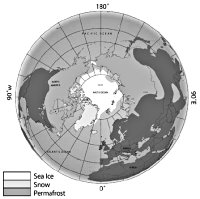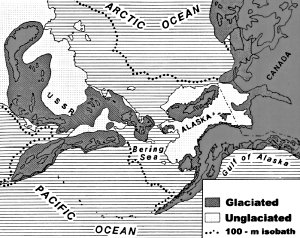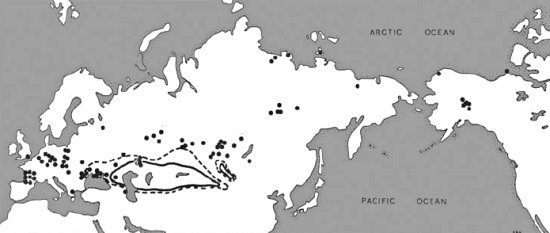Before I delve into a theory on the demise of the woolly mammoths, some preliminary questions need to be answered. Most importantly, what drew millions of woolly mammoths to the far north where the winters are currently so fiercely cold and the summers so dangerously boggy? And what did they eat while they were there?
The great Siberian death wish
In the 1970s, the musk ox was reintroduced to the Taimyr Peninsula, north central Siberia, and Wrangel Island located in the Arctic Ocean.1 If the woolly mammoth and other animals could be brought back to life, possibly by cloning, would they be able to survive in Siberia? Some scientists are even suggesting that cells from a frozen woolly mammoth carcass could possibly be introduced into a female Asian elephant, producing a hybrid.
Siberia is well known for its bitterly cold winters (see figure 2.1, below). Siberian winter temperatures average below zero Fahrenheit (below –18ºC). But minimum temperatures commonly descend colder than 40 below (ºF or ºC) in the winter. The lowest temperature ever recorded in the Northern Hemisphere is –90ºF (–68ºC) at Verkhoyansk.2 Large mammals can usually tolerate a fair amount of cold, but could they tolerate the blizzards and extreme wind chills of the winter months? Siberia’s cold season lasts nearly nine months of the year.
Interestingly, not many large mammals live in Siberia today. Vereshchagin and Baryshnikov3 express the opinion of some Russian scientists in regard to woolly mammoths:
There would be no place for mammoths in the present arctic tundra of Eurasia with its dense snow driven by the winds.
Mainstream scientists believe that during the Ice Age, winter temperatures were possibly 10 to 20ºF (6 to 12ºC) colder, making survival even more difficult.

Figure 2.1. Map with average temperatures for January and July. View full-size map. |
Summers, on the other hand, can be quite warm today due to nearly perpetual sunshine. Digby4 describes one week he spent in Yakutsk, Siberia. The mercury never dropped below 80ºF (27ºC), “night” or day! Assuming an animal somehow survived the winter, summers would be comfortable.
Some have thought that the woolly mammoths could easily have migrated into Siberia during the warmer spring and summer. After a summer of fattening on the vegetation, they would then migrate back south during the fall, before the cold of winter hit. Although a few scientists have entertained this possibility,5 this theory has fatal flaws. The woolly mammoths would have to migrate several thousand miles, before winter, which would severely tax the energy of the mammoths.6 A mammoth’s legs are heavy and require much more energy to walk than other mammals. Howorth7 further points out that any animals in northeast Siberia would have to migrate even farther. The North Pacific Ocean lies directly to the south of their path. The woolly mammoths would need to travel a few thousand miles farther west, before heading south. Another problem with the migration theory is that spring migration back to northern Siberia makes little sense. There likely would be an adequate food supply in southern Siberia or farther south.8 There would be no need to migrate north. Finally, mammoths were pregnant for 22 months, making any kind of yearly migration hazardous. Mammoth expert Gary Haynes9 summarizes the case against mammoth migration:
Mammoths would not have been capable of making the kind of yearly long-distance return treks that caribou make, because proboscidean feeding requirements would have been too great to allow continual travel and because the smaller herd members, especially weaned calves under twelve years old, would not have been able to feed as well as travel at the same rate as older adults. In addition, since mammoth gestation was at least twenty-two months (and possibly longer) many pregnant females would have had to make an annual migration twice during their pregnancy, placing an intolerable burden on themselves and fetuses in utero.

Figure 2.2. Map of permafrost zone for Northern Hemisphere (permafrost areas in general lie to the north of the average annual temperature of –6ºC to –8ºC isotherms). View full-size map. |
There is another overpowering reason why summer migration would not be likely. Travel through the summer bogs would be deadly for the mammoths. Siberia is now located in the permafrost zone in which the soil for hundreds of feet (100 m or more) deep is permanently frozen. Every summer the top one to two feet (about ½ m) melts. The ground below remains continually frozen. Melted water from the surface layer pools and forms massive bogs and muskegs. As a result, summer travel is difficult for both man and beast.10 Pfizenmayer11 describes the tremendous effort it required of his team to travel through Siberia during the summer to the location of the Beresovka mammoth. It took the men until mid-winter to haul out the mammoth. He concludes that the sticky bog mud would decimate large herds of animals. Tolmachoff12 states that a few inches (about 5 cm) of this sticky mud makes the tundra practically impassable for a man, and that a foot or more of mud would probably trap a mammoth. The woolly mammoth, especially, would have had trouble negotiating marshy ground due to its pillar-like leg structure and stiff-legged locomotion.13 Nor would it have been able to pass over any trench that even slightly exceeded its maximum stride length. Vereshchagin14 unambiguously proclaims: “Neither mammoth nor bison could exist in the sort of tundra that exists there [Siberia] today.”
Large mammals such as musk ox, caribou, and moose do live and survive in the high Arctic today. But these herbivorous animals are suited to living on boggy substrate and can eat the type of vegetation that grows in Siberia today. Caribou eat lichens, which they can smell through the snow. They migrate south before the full force of winter hits. Their hooves are well suited for walking on the snow and boggy ground. Moose, with their long legs, can browse in relatively deep snow or in bogs. These herbivores have broadly splayed hooves that decrease the load and help them negotiate swampy muskegs.15 Regardless of their advantages, the Siberian winter is still harrowing for these mammals: “Northern ungulates gradually decline in weight and body condition during the winter.”16 Mammoths and the many other types of mammals are ill suited for summer conditions in Siberia. What were millions of them doing in Siberia?
Starving to death amidst abundance
Even if somehow the Ice Age mammals survived the cold winters and the boggy summers, they still would need to find food. Siberia has abundant vegetation during the summer. Some scientists believe the mammoth and other animals could have survived on this vegetation. Farrand17 optimistically states:
People who have not been in high arctic areas appear to have little conception of the relatively luxuriant vegetation there — grasses, flowers, shrubs, and dwarf trees. It is amazing what 24 hours of sunshine a day will do!
There is one daunting problem in Farrand’s logic. Practically all these many millions of mammals ate grass and small shrubs, but Siberian vegetation today is primarily bog and muskeg vegetation. The current vegetation is low in the nutrition necessary for the health of these large animals.18 The taiga forest vegetation south of the current tundra is also non-supportive for these animals.19 The taiga vegetation, plus the woody bark of spruce, dwarf alder, and birch, that grows in Siberia today contain many toxins for mammals.20 The animals could not survive on this poor fodder. Scientists have labeled this lack of adequate food “the productivity paradox.”21 In other words, there is hardly any food in Siberia today for all those woolly mammoths and other animals! It is true that there are small patches of grassland, but this is not nearly enough for all the animals that lived there, especially for the large mammals. The woolly mammoth and its cohorts would starve to death amidst the appearance of plenty.
The problem is compounded when one understands the dietary and liquid requirements of a mammoth. A woolly mammoth can be compared to a modern elephant, since they are very similar. A large woolly mammoth would require 400 to 650 pounds (180 to 300 kg) of succulent food daily.22 Where is such feed going to come from in Siberia?
Woolly mammoths would also need to drink 35 to 50 gallons (140 to 200 liters) of water daily.23 Nearly all of the water in Siberia is frozen during the winter. Some have suggested that the woolly mammoth could have used its tusks to break icicles from cliffs or eat snow to obtain water.24 However, eating snow or ice is not an efficient method of obtaining water. It chills the body. Half the energy consumed by the woolly mammoth during winter would have been used to melt and warm the snow in its stomach.25 Also the plains of Siberia do not have many cliffs with icicles.
The climate enigma
It is rather obvious at this point that the climate and environment of Siberia had to have been much warmer when the woolly mammoth lived. Yet, paradoxically, they lived during the Ice Age. Computer models of an Ice Age climate vary in quality, but the results are consistent: Siberia had to have been much colder. Arkhipov26 concludes: “During glacial and stadial stages, the climate of Siberia was much colder than at present.” A stadial stage is the coldest part of the Ice Age. In their Ice Age climate model, Manabe and Broccoli27 calculated temperatures about 20ºF (12ºC) colder than present Siberian winters.
Many such Ice Age computer simulations even develop an ice sheet in Siberia. A good example is the simulation of Dong and Valdes.28 One of the more interesting general circulation models attempted to develop ice sheets from scratch. It provided the stimulus for ice sheet growth by reducing sunshine around the earth by 6 percent. Paradoxically, the simulation produced a permanent snow cover over Alaska, portions of Siberia, and western Canada, but little over areas where the ice sheets actually developed. This is the opposite of where the ice occurred during the Ice Age:
We now have glaciation, but mainly outside the area where it existed during the last Ice Age.29
These computer simulations show how easy it is to glaciate Siberia, but something is very wrong. How could the woolly mammoths have survived in Siberia when it supposedly was covered by ice?
Glacial debris indicates that only the mountains of Siberia, Alaska, and the Yukon were actually glaciated. The lowlands, where the mammoth bones are found, were never glaciated! That would explain how the animals could live in these areas during the Ice Age. But why were these lowlands not glaciated?

Figure 2.3. Glaciated and unglaciated areas of Siberia, Alaska, and the Yukon during the Ice Age. The shallow continental shelf is shown by the 330-foot (100m) isobath, which is a line of constant depth of the sea. |
Some uniformitarian scientists, eager to justify their model, reason that a colder Ice Age climate would have helped the woolly mammoth live in Siberia. Colder temperatures would cause less melting of the permafrost, so the tundra and taiga would have been much less boggy in summer. This situation would certainly help the mammoths negotiate the marshy terrain if it remained frozen. However, a colder climate would cause a shorter growing season with much less food and liquid water. Furthermore, some of the animals could not even endure the cold of today, much less a colder Ice Age.
Once again, what would all the animals eat in such a colder Ice Age? Not much edible vegetation would grow in such a climate. Colder Ice Age temperatures aggravate the productivity paradox. Charles Schweger30 describes the problem this way:
The former presence of larger and more diverse ungulate [hooved mammal] populations in northern regions of periglacial [near a glacier] climate at a time when primary productivity presumably was still lower constitutes the paradox. To oversimplify, how does one keep a mammoth alive and well under the seemingly impossible conditions of Ice Age Beringia? [Beringia is eastern Siberia, Alaska, and the Yukon.]
The climate paradox worsens when we look at the animals themselves. Dead bones, of course, do not speak, but they can provide clues to the environment they occupied. The diversity of mammals and their specific ecological requirements strongly suggest an environment quite different from today and far different than the Ice Age climate simulations. The environment of Siberia during the Ice Age has been compared to that of the Serengeti of East Africa!31
Based on the fact that practically all these large mammals were grazers that ate a wide variety of herbaceous vegetation, mainly grasses, we can recreate the environment of Siberia. These deductions are based on (1) the food preferences of the surviving mammals, (2) the elephant as an analog for the mammoth, (3) the stomach contents of frozen carcasses that contain abundant grasses, and (4) mammoth dung preserved in caves of the southwest United States.32 This leads us to conclude that Siberia was a huge grassland during the Ice Age! Dale Guthrie, whom I believe comes closest to understanding the environment of Siberia during the woolly mammoth era, calls Siberia a mammoth steppe. A steppe is a semi-arid plain with abundant grass and few trees. There are two main steppes in the world today: (1) the high plains east of the Rocky Mountains in the United States and (2) the north slopes of the central Asian mountains.
Some of the smaller mammals especially reinforce Guthrie’s conclusion of a mammoth steppe. The smaller mammal bones found include badgers and ferrets. They occupy short-grass plains, similar to the high plains east of the Rocky Mountains in central North America.33 These animals burrow fairly deep, suggesting a lack of permafrost. A grassland environment is further indicated by a wide distribution of Arctic ground squirrels, which live in open country and require energy-rich seeds and protein-rich herbs.34
To sustain this large mix of animals, the grassland must have had a rich variety of plants similar to other grasslands. Guthrie35 logically concluded that the plants were also highly diverse — a diversity that has no modern counterpart in the world today.36 Small communities of tall bushes and trees punctuated this huge grassland in places. These are found preserved in the permafrost.37 Based on the large number of healthy individuals, Guthrie also concludes that Siberia, Alaska, and the Yukon, as well as Europe and western Russia, was one huge diverse grassland. The mammoth steppe seemed to cover much of the non-glaciated area of the Northern Hemisphere.
In order for such a diverse grassland to exist, the soil must have been very fertile.38 The existence of a fertile soil with abundant nutrients is reinforced by the lack of chew marks, called pica, on the Siberian mammal bones.39 Small animals in many environments today do not obtain enough minerals in their food because the soil cannot provide enough nutrients. So they chew bones of dead animals to obtain missing nutrients.
The growth pattern of the mammals also suggests a fertile grassland.40 Most of the mammals have been described as well-dressed giants. Horses, woolly rhinoceroses, and woolly mammoths were smaller than their counterparts farther south, but all the other animals were significantly larger than their counterparts today. Moreover, the shaggy ruffs, heavy horns, long tusks, and enormous antlers on many animals are what wildlife managers would recognize as indicators of high-quality habitat with little competition and a long growing season.41 Abundant soil nutrients especially affect the size of both the animal and its social organs.42 Bergmann’s rule states that the colder the climate the larger the animal. However, others strongly dispute Bergmann’s rule and maintain that size is proportional to the quality of feed during the growth season.43 Guthrie44 demonstrated the size-nutrient association with an experiment on dall sheep in Alaska: they grew bigger with more feed.

Figure 2.4. Present (solid line), historical (dashed line), and Ice Age (dots) distribution of the saiga antelope. |
To maintain such a large variety of herbaceous vegetation requires a long growing season with warm soil and rapid spring growth.45 Such a climate differs greatly from the current environment, where there isn’t even a green sprout in northern Siberia until mid-June to early July.46 Steppe climates have a wet spring and a dry late summer and early autumn, the kind of climate necessary to maintain a grassland. Consequently, it is reasonable to expect a similar precipitation pattern for Siberia during the mammoth era.
Ninety percent of grass biomass is in the roots below the surface. The plant cannot sprout fresh shoots until the snow melts and the soil warms. Steppe environments are characterized by low soil moisture and light winter snowfall.47 This further implies that winter snows must have been light and melted early. A mild, relatively dry winter would favor such a spring resurgence.
The presence of several animals that are intolerant of deep snow, such as the saiga antelope, bighorn sheep, dall sheep, and wolf, also suggests open range with light winter snowfall.48 Bison are quite efficient at scraping away snow with their head and horns, but when the snow exceeds a depth of two feet, they have difficulty obtaining enough food. In central Alaska where many bison remains are found in the permafrost, the snow usually accumulates up to three feet or more. Bison cannot live in central Alaska, except in small, windswept areas.49
In summary, the ecology of the Siberian animals suggests a much more diverse vegetation with a fertile soil. This further implies a comparatively mild winter with light snowfall and a long growing season. These conditions differ markedly from the modern environment and climate, not to mention uniformitarian computer simulations of the Ice Age climate. http://www.answersingenesis.org/home/area/fit/chapter2.asp